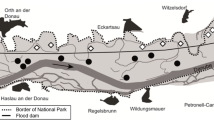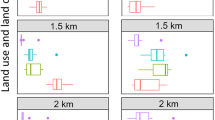Abstract
Land-use alteration and climate seasonality have profound effects on bee species diversity by influencing the availability of nesting and floral resources. Here, using twelve sites embedded in an agriculture–forest mosaic in the tropical highlands of Guatemala, we investigated the relative effects of climate seasonality and landscape heterogeneity on bee and floral-resource community structure and on their mutualistic network architecture. We found that climate seasonality affected bee diversity, which was higher in the wet season and associated positively with the availability of floral resources across both seasons. Bee community composition also differed between seasons and it was mainly driven by floral-resource richness and the proportion of agricultural, semi-natural and forest cover. In addition to the effects on bee diversity, climate seasonality also affected flower–bee visitation networks. We documented higher relative (null model corrected) nestedness in the dry season compared to the wet season. Niche partitioning as a result of competition for scarce resources in the dry season could be the process driving the differences in the network structure between seasons. Furthermore, relative nestedness was consistently smaller than zero, and relative modularity and specialization were consistently larger than zero in both seasons, suggesting the existence of isolated groups of interacting partners in all our flower–bee visitation networks. Our results highlight the effect of climatic seasonality and the importance of preserving local floral resources and natural heterogeneous habitats for the conservation of bee communities and their pollination services in tropical highlands.




Similar content being viewed by others
Data availability
All data are included as supplementary material.
References
Abrahamczyk S, Kluge J, Gareca Y, Reichle S, Kessler M (2011) The influence of climatic seasonality on the diversity of different tropical pollinator groups. PLoS ONE 6:e27115. https://doi.org/10.1371/journal.pone.0027115
Ahrné K, Bengtsson J, Elmqvist T (2009) Bumble bees (Bombus spp.) along a gradient of increasing urbanization. PLoS ONE 4:e5574. https://doi.org/10.1371/journal.pone.0005574
Almeida-Neto M, Guimarães PRJ, Loyola RD, Ulrich W (2008) A consistent metric for nestedness analysis in ecological systems: reconciling concept and measurement. Oikos 117:1227–1239
Bascompte J, Jordano P (2014) Mutualistic networks. Princeton University Press, Princeton
Bastolla U, Fortuna MA, Pascual-García A, Ferrera A, Luque B, Bascompte J (2009) The architecture of mutualistic networks minimizes competition and increases biodiversity. Nature 458:1018–1020
Bates D, Mächler M, Bolker B, Walker S (2015) Fitting linear mixed-effects models using lme4. J Stat Softw 67:1–48
Berecha G, Aerts R, Muys B, Honnay O (2015) Fragmentation and management of Ethiopian moist evergreen forest drive compositional shifts of insect communities visiting wild Arabica coffee flowers. Environ Manag 55:373–382
Biesmeijer JC, Roberts SPM, Reemer M et al (2006) Parallel declines in pollinators and insect-pollinated plants in Britain and the Netherlands. Science 313:351–354
Bivand R, Piras G (2015) Comparing implementations of estimation methods for spatial econometrics. J Stat Softw 63:1–36
Bivand R, Hauke J, Kossowski T (2013) Computing the jacobian in gaussian spatial autoregressive models: an illustrated comparison of available methods. Geogr Anal 45:150–179
Blüthgen N, Menzel F, Blüthgen N (2006) Measuring specialization in species interaction networks. BMC Ecol 6:9. https://doi.org/10.1186/1472-6785-6-9
Brosi BJ, Daily GC, Shih TM, Oviedo F, Durán G (2008) The effects of forest fragmentation on bee communities in tropical countryside. J Appl Ecol 45:773–783
Brown MJF, Paxton RJ (2009) The conservation of bees: a global perspective. Apidologie 40:410–416
Caudill S, Brokaw J, Doublet D, Rice R (2017) Forest and trees: shade management, forest proximity and pollinator communities in southern Costa Rica coffee agriculture. Renew Agr Food Syst 32:417–427
Dalsgaard B, Schleuning M, Maruyama PK, Dehling DM, Sonne J, Vizentin-Bugoni J, Zanata TB, Fjeldså J, Böhning-Gaese K, Rahbek C (2017) Opposed latitudinal patterns of network-derived and dietary specialization in avian plant-frugivore interaction systems. Ecography 40:1395–1401
Dáttilo W, Rico-Gray V (2018) Ecological networks in the tropics. Springer, Berlin
De Palma A, Abrahamczyk S, Aizen MA et al (2016) Predicting bee community responses to land-use changes: effects of geographic and taxonomic biases. Sci Rep 6:31153. https://doi.org/10.1038/srep31153
Dormann CF, Strauss R (2014) A method for detecting modules in quantitative bipartite networks. Methods Ecol Evol 5:90–98
Dormann CF, Frund J, Blüthgen N, Gruber B (2009) Indices, graphs and null models: analyzing bipartite ecological networks. Open Ecol J 2:7–24
ESRI (2008) ArcGIS desktop: Release 9.3. Environmental Systems Research Institute, Redlands
Fisher K, Gonthier DJ, Enis KK, Perfecto I (2017) Floral resource availability from groundcover promotes bee abundance in coffee agroecosystems. Ecol Appl 27:1815–1826
Flora Mesoamericana (2018) https://www.tropicos.org/Project/FM. Accessed 4 Dec 2018.
Franceschinelli EV, Elias MAS, Bergamini LL, Silva-Neto CM, Sujii ER (2017) Influence of landscape context on the abundance of native bee pollinators in tomato crops in Central Brazil. J Insect Conserv 21:715–726
Gálvez J, Andrews KL et al (2014) Perfil del agro y la ruralidad de Guatemala 2014: Situación actual y tendencias. In: Cleaves C (ed) Guatemala: Universidad Rafael Landívar/Instituto de Agricultura, Recursos Naturales y Ambiente IARNA. Instituto Interamericano de Cooperación para la Agricultura IICA, Delhi
Garibaldi L, Steffan-Dewenter I, Winfree R et al (2013) Wild pollinators enhance fruit set of crops regardless of honey-bee abundance. Science 339:1608–1611
Geeraert L, Aerts R, Jordaens K, Dox I, Wellens S, Couri M, Berecha G, Honnay O (2018) Intensification of Ethiopian coffee agroforestry drives impoverishment of the Arabica coffee flower visiting bee and fly communities. Agroforest Syst 93:1729–1739
González-Varo JP, Biesmeijer JC, Bommarco R, Potts SG, Schweiger O, Smith HG, Steffan-Dewenter I, Szentgyörgyi H, Woyciechowski M, Vilà M (2013) Combined effects of global change pressures on animal-mediated pollination. Trends Ecol Evol 28:524–530
Greenleaf SS, Williams NM, Winfree R, Kremen C (2007) Bee foraging ranges and their relationship to body size. Oecologia 153:589–596
Grupo Interinstitucional de Monitoreo de Bosques y Uso de la Tierra (2014) Mapa de bosques y uso de la tierra 2012 y Mapa de cambios en uso de la tierra 2001- 2010 para estimación de emisiones de gases de efecto invernadero. Universidad del Valle de Guatemala, Consejo Nacional de Áreas Protegidas, Instituto Nacional de Bosques, Ministerio de Agricultura, Ganadería y Alimentación, Ministerio de Ambiente y Recursos Naturales, Facultad de Agronomía de la Universidad de San Carlos de Guatemala.
Gutiérrez-Chacón C, Dormann CF, Klein AM (2018) Forest-edge associated bees benefit from the proportion of tropical forest regardless of its edge length. Biol Conserv 220:149–160
Heithaus ER (1979) Community structure of neotropical flower visiting bees and wasps: diversity and phenology. Ecology 60:190–202
Hipolito J, Boscolo D, Felipe Viana B (2018) Landscape and crop management strategies to conserve pollination services and increase yields in tropical coffee farms. Agric Ecosyst Environ 256:218–225
Holland FD, Bert DG, Fahrig L (2004) Determining the spatial scale of species response to habitat. Bioscience 54:227–233
Hrncir M, Jarau S, Barth FG (2016) Stingless bees (Meliponini): senses and behavior. J Comp Physiol A 202:597–601
INSIVUMEH (2019) Instituto Nacional de Sismología, Vulcanología, Meterorología e Hidrología. https://www.insivumeh.gob.gt/. Accessed 27 Oct 2019.
IPBES (2016) The assessment report of the Intergovernmental Science-Policy Platform on Biodiversity and Ecosystem Services on pollinators, pollination and food production. In: Potts SG, Imperatriz-Fonseca VL, Ngo HT (eds) Secretariat of the Intergovernmental Science-Policy Platform on Biodiversity and Ecosystem Services. IPBES, Bonn
Jauker B, Krauss J, Jauker F, Steffan-Dewenter I (2013) Linking life history traits to pollinator loss in fragmented calcareous grasslands. Landsc Ecol 28:107–120
Jha S, Vandermeer JH (2010) Impacts of coffee agroforestry management on tropical bee communities. Biol Conserv 143:1423–1431
Kaiser-Bunbury CN, Blüthgen N (2015) Integrating network ecology with applied conservation: A synthesis and guide to implementation. AoB Plants 7:plv076. https://doi.org/10.1093/aobpla/plv076
Kennedy CM, Lonsdorf E, Neel MC et al (2013) A global quantitative synthesis of local and landscape effects on wild bee pollinators in agroecosystems. Ecol Lett 16:584–599
Kleijn D, Winfree R, Bartomeus I et al (2015) Delivery of crop pollination services is an insufficient argument for wild pollinator conservation. Nat Commun 6:7414. https://doi.org/10.1038/ncomms8414
Klein AM (2009) Nearby rainforest promotes coffee pollination by increasing spatio-temporal stability in bee species richness. Forest Ecol Manag 258:1838–1845
Klein AM, Steffan-Dewenter I, Buchori D, Tscharntke T (2002) Effect of land-use intensity in tropical agroforestry systems on coffee flower-visiting and trap-nesting bees and wasps. Conserv Biol 16:1003–1014
Klein AM, Cunningham SA, Bos M, Steffan-Dewenter I (2008) Advances in pollination ecology from tropical plantation crops. Ecology 89:935–943
Kremen C, Williams NM, Thorp RW (2002) Crop pollination from native bees at risk from agricultural intensification. Proc Natl Acad Sci USA 99:16812–16816
Landaverde-González P, Quezada-Euán JJG, Theodorou P, Murray TE, Husemann M, Ayala R, Moo-Valle H, Vandame R, Paxton JR (2017) Sweat bees on hot chillies: provision of pollination services by native bees in traditional slash-and-burn agriculture in the Yucatán Peninsula of tropical Mexico. J Appl Ecol 54:1814–1824
Landaverde-González P, Baltz L, Escobedo-Kenefic N, Mérida J, Paxton RJ, Husemann M (2018) Recent low levels of differentiation in the native Bombus ephippiatus (Hymenoptera: Apidae) along two Neotropical mountain-ranges in Guatemala. Biodivers Conserv 27:3513–3531
Landi P, Minoarivelo HO, Brännström Å, Hui C, Dieckmann U (2018) Complexity and stability of ecological networks: a review of the theory. Popul Ecol 60:319–345
Lichtenberg EM, Mendenhall CD, Brosi BJ (2016) Foraging traits modulate stingless bee community disassembly under forest loss. J Anim Ecol 86:1404–1416
Lorenzon MCA, Matrangolo CAR (2005) Foraging on some nonfloral resources by stingless bees (Hymenoptera, Meliponini) in a caatinga region. Braz J Biol 65:291–298
Mayes D, Bhatta C, Shi D, Bron JC, Smith D (2019) Body size influences stingless bee (Hymenoptera: Apidae) communities across a range of deforestation levels in Rondônia, Brazil. J Insect Sci 19:1–7
Meléndez Ramírez V, Ayala R, González HD (2016) Temporal variation in native bee diversity in the tropical sub-deciduous forest of the yucatan peninsula, Mexico. Trop Conserv Sci 9:718–734
Memmott J, Waser NM, Price MV (2004) Tolerance of pollination networks to species extinctions. P Roy Soc B-Biol Sci 271:2605–2611
Memmott J, Gibson R, Carvalheiro L, Henson K, Heleno R, Mickel M, Pearce S (2007) The conservation of ecological interactions. In: Stewart AJA, New TR, Lewis OT (Eds) Insect Conservation Biology: Proceedings of the Royal Entomological Society's 23rd Symposium. CABI, United Kingdom, pp 226–244.
Morrison B, Brosi BJ, Dirzo R (2020) Agricultural intensification drives changes in hybrid network robustness by modifying network structure. Ecol Lett 23:359–369
Nascimento DL, Nascimento FS (2012) Extreme effects of season on the foraging activities and colony productivity of a stingless bee (Melipona asilvai Moure, 1971) in Northeast Brazil. Psyche 2012:267361. https://doi.org/10.1155/2012/267361
Ngo HT, Gibbs J, Griswold T, Packer L (2013) Evaluating bee (Hymenoptera: Apoidea) diversity using Malaise traps in coffee landscapes of Costa Rica. Can Entomol 145:435–453
Nigh R, Diemont SAW (2013) The Maya milpa: fire and the legacy of living soil. Front Ecol Environ 11:e45–e54. https://doi.org/10.1890/120344
Oksanen J, Blanchet FG, Kindt R, et al (2018) Package “vegan”: Community ecology package. https://vegan.r-forge.r-project.org/ (ISBN 0-387-95457-0)
Ollerton J, Winfree R, Tarrant S (2011) How many flowering plants are pollinated by animals? Oikos 120:321–326
Ollerton J, Erenler H, Edwards M, Crockett R (2014) Extinctions of aculeate pollinators in Britain and the role of large-scale agricultural changes. Science 346:1360–1362
Patefield WM (1981) Algorithm AS 159: an efficient method of generating random R x C tables with given row and column totals. J R Stat Soc C-Appl 30:91–97
Potts S, Vulliamy B, Dafni A, Neeman G, Willmer P (2003) Linking bees and flowers: how do floral communities structure pollinator communities? Ecology 84:2628–2642
Potts SG, Biesmeijer JC, Kremen C, Neumann P, Schweiger O, Kunin WE (2010) Global pollinator declines: trends, impacts and drivers. Trends Ecol Evol 25:345–353
Poveda-Coronel CA, Riaño-Jiménez D, Cure JR (2018) Diversity and phenology of wild bees in a highly disturbed tropical dry forest “Desierto de la Tatacoa”, Huila-Colombia. Neotrop Entomol 47:786–790
Powney GD, Carvell C, Edwards M, Morris RKA, Roy HE, Woodcock BA, Isaac NJB (2019) Widespread losses of pollinating insects in Britain. Nat Commun 10:1018. https://doi.org/10.1038/s41467-019-08974-9
Rabeling SC, Lim JL, Tidon R, Neff JL, Simpson BB, Pawar S (2019) Seasonal variation of a plant-pollinator network in the Brazilian Cerrado: implications for community structure and robustness. PLoS ONE 14:e0224997. https://doi.org/10.1371/journal.pone.0224997
Ramírez SR, Hernández C, Link A, López-Uribe MM (2015) Seasonal cycles, phylogenetic assembly, and functional diversity of orchid bee communities. Ecol Evol 5:1896–1907
Ricketts TH (2004) Tropical forest fragments enhance pollinator activity in nearby coffee crops. Conserv Biol 18:1262–1271
Samnegård U, Hambäck PA, Eardley C, Nemomissa S, Hylander K (2015) Turnover in bee species composition and functional trait distributions between seasons in a tropical agricultural landscape. Agric Ecosyst Environ 211:185–194
Schleuning M, Ingmann L, Strauß R, Fritz SA, Dalsgaard B, Dehling DM, Plein M, Saavedra F, Sandel B, Svenning JC, Böhning-Gaese K, Dormann CF (2014) Ecological, historical and evolutionary determinants of modularity in weighted seed-dispersal networks. Ecol Lett 17:454–463
Simmons BI, Sutherland WJ, Dicks LV, Albrecht J, Farwig N, García D, Jordano P, González-Varo JP (2018) Moving from frugivory to seed dispersal: Incorporating the functional outcomes of interactions in plant-frugivore networks. J Anim Ecol 87:995–1007
Smith TJ, Mayfield MM (2018) The effect of habitat fragmentation on the bee visitor assemblages of three Australian tropical rainforest tree species. Ecol Evol 8:8204–8216
Souza C, Maruyama PK, Aoki C, Sigrist MR, Raizer J, Gross CL, Araujo AC (2018) Temporal variation in plant-pollinator networks from seasonal tropical environments: higher specialization when resources are scarce. J Ecol 106:2409–2420
Spiesman BJ, Inouye BJ (2013) Habitat loss alters the architecture of plant-pollinator interaction networks. Ecology 94:2688–2696
Standley PC, Steyermark JA (1946) Flora of Guatemala. Fieldiana botany. Chicago Natural History Museum, Chicago
Thebault E, Fontaine C (2010) Stability of ecological communities and the architecture of mutualistic and trophic networks. Science 329:853–856
Theodorou P, Radzevičiūtė R, Settele J, Schweiger O, Murray TE, Paxton RJ (2016) Pollination services enhanced with urbanization despite increasing pollinator parasitism. P Roy Soc B-Biol Sci 283:20160561. https://doi.org/10.1098/rspb.2016.0561
Theodorou P, Albig K, Radzevičiūtė R, Settele J, Schweiger O, Murray TE, Paxton RJ (2017) The structure of flower visitor networks in relation to pollination across an agricultural to urban gradient. Funct Ecol 31:838–847
Theodorou P, Radzevičiūtė R, Lentendu G, Kahnt B, Husemann M, Bleidorn C, Settele J, Schweiger O, Grosse I, Wubet T, Murray TE, Paxton RJ (2020) Urban areas as hotspots for bees and pollination but not a panacea for all insects. Nat Commun 11:576. https://doi.org/10.1038/s41467-020-14496-6
Thompson H, Schneider C, Maus C, Camata C, Wolff C (2019) Prevalence and abundance of bees visiting major conventionally managed agricultural crops in Brazil. J Apic Res 59:246–260
Vergara CH, Badano EI (2009) Pollinator diversity increases fruit production in Mexican coffee plantations: the importance of rustic management systems. Agric Ecosyst Environ 129:117–123
Winfree R, Griswold T, Kremen C (2007) Effect of human disturbance on bee communities in a forested ecosystem. Conserv Biol 21:213–223
Winfree R, Bartomeus I, Cariveau DP (2011) Native pollinators in anthropogenic habitats. Annu Rev Ecol Evol Syst 42:1–22
Zuur A, Ieno EN, Walker N, Saveliev AA, Smith GM (2009) Mixed effects models and extensions in ecology with R. Springer-Verlag, New York
Acknowledgements
We thank the Posgrado en Ciencias Biológicas, Universidad Nacional Autónoma de Mexico, for its support in the conception and design of this work, which will be presented as a part of the thesis of NEK to acquire the Doctoral Degree; and the Universidad de San Carlos de Guatemala for providing financial and logistical support. We also thank Terry Griswold for aiding in taxonomic identification of bees, Jessica López for curation and identification of plants, María José Hernández for field work support, María del Coro Arizmendi for her recommendations and Eunice Enríquez for her continued support.
Funding
This study was funded by the Dirección General de Investigación (DIGI), Universidad de San Carlos de Guatemala, through the grant 4.8.63.2.27–2012.
Author information
Authors and Affiliations
Contributions
NEK, MJD and CD designed the study; NEK, EC, MJD, PLG and OM collected, cured and made taxonomical identifications of the data, PLG and PT analysed the data; NEK, PLG and PT wrote the manuscript. All the authors reviewed and agreed to the manuscript.
Corresponding authors
Ethics declarations
Conflict of interest
The authors declare that they have no conflict of interest.
Additional information
Communicated by Ingolf Steffan-Dewenter.
Our study provides novel insights into the effects of climatic seasonality, local resources and land-use on bee communities and flower visitation networks in the understudied tropical highlands.
Electronic supplementary material
Below is the link to the electronic supplementary material.
Rights and permissions
About this article
Cite this article
Escobedo-Kenefic, N., Landaverde-González, P., Theodorou, P. et al. Disentangling the effects of local resources, landscape heterogeneity and climatic seasonality on bee diversity and plant-pollinator networks in tropical highlands. Oecologia 194, 333–344 (2020). https://doi.org/10.1007/s00442-020-04715-8
Received:
Accepted:
Published:
Issue Date:
DOI: https://doi.org/10.1007/s00442-020-04715-8




